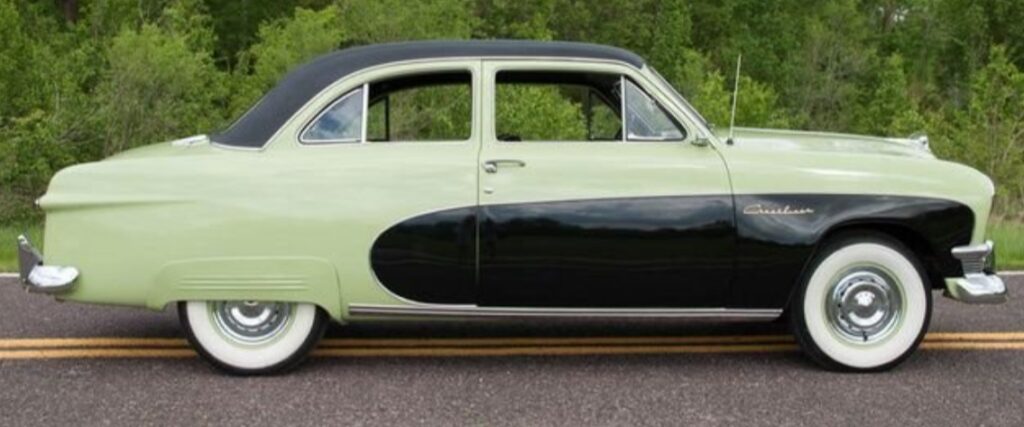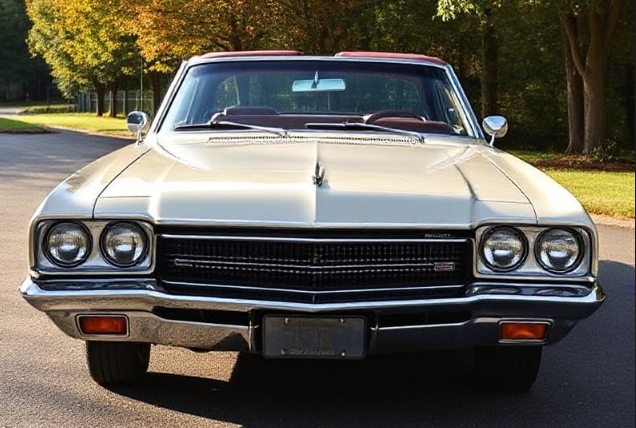The Ford Crestliner: A Tale of Ford’s Evolving Glamour and Practicality
The Ford Crestliner. The name itself evokes a sense of grandeur, of journeys bathed in sunlight, and of a bygone era of automotive optimism. More than just a model, the Crestliner was a statement, a carefully crafted blend of style and substance that mirrored Ford’s ambition to capture a broad swathe of the American automotive market throughout the late 1940s and 1950s. Its evolution tells a compelling story of design trends, technological advancements, and the enduring appeal of a well-executed automobile.
From its inception, the Crestliner was positioned as a premium offering within Ford’s lineup. It wasn’t the entry-level Model 700, nor was it the ultra-luxury Continental. Instead, it occupied a sweet spot, offering buyers a taste of luxury and distinctive styling without venturing into prohibitive price brackets. This strategic positioning, coupled with a keen understanding of evolving consumer desires, allowed the Crestliner to carve out a significant niche and become a recognizable icon of its time.
The Dawn of a New Era: 1949
The true genesis of the Crestliner can be traced to the revolutionary 1949 Ford. This year marked a radical departure from the pre-war styling that had characterized Ford’s offerings for years. The post-war automotive landscape was clamoring for something new, something modern, and Ford delivered with a sleek, slab-sided design that was a stark contrast to the bulbous, flowing lines of its predecessors.
Within this groundbreaking new design, the Ford Crestliner emerged as the top-tier model. It wasn’t entirely a separate model in the way we might think of it today, but rather a specific trim level and body style that elevated the standard Ford sedan. The 1949 Crestliner was exclusively offered as a two-door sedan. Its key distinguishing features were its luxurious interior appointments and, most notably, its distinctive two-tone paint schemes. This was the era of vibrant, optimistic colors, and the Crestliner embraced this with flair. Buyers could choose from a palette of striking combinations, often featuring a darker main color with a contrasting lighter color on the roof and the distinctive “Crestliner” side trim. This dual-tone approach was a significant visual cue, setting it apart from lesser Fords and immediately signaling its upscale status.
Under the sculpted hood, the 1949 Crestliner offered two engine options: the reliable 226 cubic inch “Mileage Maker” inline-six engine, producing around 95 horsepower, and the more powerful 239 cubic inch “Flathead” V8 engine, delivering approximately 100 horsepower. While the Flathead V8 was a hallmark of Ford’s engineering prowess at the time, the emphasis for the Crestliner was as much on its visual appeal as its performance.
The interior of the 1949 Crestliner was also a step above. Plush upholstery, often in fabric or leatherette, along with chrome accents and a more refined dashboard design, contributed to the feeling of luxury. The “Crestliner” badging, typically found on the exterior trim and sometimes on the interior dashboard, served as a constant reminder of its exalted position in the Ford hierarchy.
.
SEARCHING for those hard to find FORD manuals, guides & books?
This place has you covered! SEE All FORD Manuals From 1920 – 1989.
CHOOSE the year of your vehicle:

.
Refinement and Expansion: 1950-1951
The success of the 1949 design paved the way for the 1950 and 1951 models, which saw incremental refinements rather than radical overhauls. The core design language remained, but subtle tweaks enhanced the Crestliner’s appeal.
For 1950, the Crestliner continued to be a distinguished trim level on the existing Ford body styles. The two-tone paint schemes remained a central element, with slightly updated color palettes. The two-door sedan continued to be the primary body style offered under the Crestliner moniker. Minor styling cues were adjusted, such as the grille design and the shape of the side trim, to keep the car feeling fresh and competitive. The engine options remained the same inline-six and V8 powerplants. The focus was on solidifying the Crestliner’s identity as a stylish and comfortable choice for the discerning buyer.
The 1951 model year saw a more significant evolution. While the Crestliner was still a trim level, it began to be associated more broadly with Ford’s “Custom” series. This was a crucial step in its development, as it started to signal the Crestliner’s integration into a more defined range of upscale Ford models. The two-tone paint options continued to be a signature feature, and the interior offered even more luxurious appointments. The iconic “Crestliner” script badge became more prominent, reinforcing its distinct identity. The two-door sedan remained the sole body style available as a Crestliner. Mechanically, the engines saw minor power bumps, with the inline-six now producing around 100 horsepower and the V8 pushing closer to 110 horsepower, reflecting the ongoing engineering developments of the era.
The “Fairlane” Era and the Crestliner’s Identity Shift: 1952-1954
The 1952 model year marked a notable shift in Ford’s naming conventions and design philosophy, which directly impacted the Crestliner’s future. Ford introduced the entirely new “Blue Oval” styling, characterized by a more integrated grille and fender design. Within this new generation, the Fairlane name emerged, and it would ultimately become intrinsically linked with the Crestliner.
For 1952, the Crestliner was still a distinct trim level, primarily offered as a luxurious two-door sedan. However, the Fairlane name began to be used to denote the top-tier models within Ford’s lineup. The Crestliner was effectively the pinnacle of the Fairlane series. The two-tone paint schemes continued, and the interior featured upgraded fabrics and trim. The “Crestliner” badging remained a key identifier. The engines were updated with the new Y-block V8 engine becoming the dominant power option, offering a significant improvement in performance and refinement over the old Flathead. This Y-block V8, available in various displacements and power outputs, would become a staple of Ford performance for years to come.
In 1953, the Crestliner remained the top trim within the Fairlane series. The styling underwent further refinement, with a more pronounced “jet-age” influence starting to creep into the design. The grille became wider, and chrome trim was used more liberally. The Crestliner, as the most opulent offering, received the most elaborate chrome detailing and upholstery options. The two-tone paint remained a crucial element, and buyers had an even wider array of color combinations to choose from. The two-door sedan was still the primary body style.
The 1954 model year saw the Crestliner solidify its position as the embodiment of Ford’s premium offering within the Fairlane range. The styling continued to evolve, with a more integrated look and a bolder grille. The term “Crestliner” was now almost synonymous with the highest level of trim and luxury Ford offered in its standard passenger cars. The two-door sedan was the typical Crestliner body style, but this year also saw the introduction of the Crestliner Victoria, a hardtop coupe that offered the same level of luxury and styling flair in a sleek, pillarless design. This was a significant expansion, catering to the growing desire for sporty, yet comfortable, coupes. The Y-block V8 engine was refined, offering more power and smoother operation. The interior was lavish, with plush seating, enhanced dashboard details, and plenty of chrome.
The Pinnacle of Crestliner: 1955-1956
The mid-1950s represented the absolute zenith of the Crestliner’s prominence and iconic status. The 1955 and 1956 models are perhaps the most celebrated and recognizable iterations of this glamorous Ford.
For 1955, the Crestliner was now unequivocally the top trim level of the Ford Fairlane. The exterior design was dramatically restyled, embracing the burgeoning “tailfin” era and featuring a lower, wider stance. The Crestliner was available in several body styles, cementing its place as a truly comprehensive luxury offering. The primary models were:
- Fairlane Crown Victoria: This was the absolute flagship. Featuring a distinctive stainless-steel roof band that divided the roofline, the Crown Victoria was the epitome of post-war American automotive design. It was a two-door hardtop coupe.
- Fairlane Victoria: A standard two-door hardtop coupe without the stainless-steel roof band.
- Fairlane Town Victoria: A two-door sedan with a formal roofline.
- Fairlane Sunliner: A highly popular two-door convertible.
The Crestliner designation was often applied to these top-tier Fairlane models, emphasizing their luxurious appointments and distinctive styling. The two-tone paint schemes were more elaborate than ever, often featuring sweeping side panels and chrome accents that highlighted the car’s aggressive, yet elegant, lines. The interiors were sumptuously appointed with high-quality fabrics, leather accents, and a wealth of chrome. The Y-block V8 engines were more potent, with options like the Thunderbird Y-block V8 offering significant performance.
The 1956 model year saw further refinement of the successful 1955 design. The Crestliner continued to represent the pinnacle of Ford’s Fairlane lineup. The styling cues were updated, with a new grille and revised trim. The model hierarchy remained largely the same, with the Fairlane Crown Victoria, Fairlane Victoria, Fairlane Town Victoria, and Fairlane Sunliner all available with Crestliner-level luxury. The emphasis remained on luxurious interiors, distinctive two-tone paint schemes, and the availability of the powerful Y-block V8 engines. The Crestliner was now firmly established as a symbol of American aspiration and automotive style.
The Crestliner Fades, But Its Legacy Endures: 1957 Onwards
As the automotive landscape continued to evolve at a rapid pace, the specific nomenclature of “Crestliner” began to be phased out. For 1957, Ford introduced an all-new range of models, and while the spirit of the Crestliner lived on in the top-tier Fairlane models, the name itself was no longer prominently used as a distinct trim level. The Fairlane 500 series effectively assumed the role of Ford’s premium offering, with models like the Fairlane 500 Skyliner (with its groundbreaking retractable hardtop roof) and the Fairlane 500 Sunliner embodying the luxury and style that the Crestliner had once represented.
The term “Crestliner” might have appeared in specific marketing materials or as an option package on some models in the late 1950s, but it was no longer the defining name of a top trim level. The focus shifted to the more advanced “Fairlane” moniker and its sub-designations.
The Enduring Legacy
The Ford Crestliner, though its existence as a distinct model or trim level was relatively brief, left an indelible mark on automotive history. It represented a crucial period of design innovation and market positioning for Ford. From its debut as the luxurious two-tone two-door sedan of 1949, through its integration with the Fairlane series and its ultimate evolution into the stylish hardtops and convertibles of the mid-1950s, the Crestliner consistently offered buyers a taste of glamour, comfort, and aspirational style.
Its evolution mirrors the post-war American dream – a dream of progress, of technological advancement, and of achieving a more comfortable and stylish life. The Crestliner, with its distinctive styling, luxurious appointments, and powerful engines, was a tangible manifestation of that dream on wheels. Today, surviving examples of the Ford Crestliner are highly sought after by collectors, a testament to its enduring appeal and its significant place in the rich tapestry of Ford’s automotive heritage. It remains a symbol of an era when cars were not just transportation, but also expressions of personality, optimism, and the open road.








